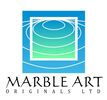FOLLOWING ON FROM MIXING YOUR FLOATER CORRECTLY...
To avoid sinking paint, don’t squirt the paint out of the pipette
into the floater, it sinks due to the force of paint. Try be less heavy handed.
Other reasons to avoid sinking paint in the floater and best printing results:
Correctly mix your paint:
MIX ONE PART PAINT TO ONE PART TAP WATER as per instructions.
I use a one part pipette of Tap Water : one part pipette of paint from the concentrated liquid pots of paint provided in your kit
I do this for all the colours in my Marble Art Kit (red, yellow, blue, black, white) into the empty containers with lids.
After my primaries are mixed, I can now mix my secondary colours with my mixed primary colours, into other empty containers.
Diluted yellow + diluted red = orange; Diluted blue + diluted yellow = green; Diluted red + diluted blue = purple etc. up to 800 variations.
Keep the paints mixed correctly:
Remember to always remix the mixed diluted paint and water, with the pipette in each container, before drawing up the paint into the pipette, to drop onto your floater liquid. (Reason being the mixed paint can separate from the water, it was initially mixed with at the start, and sinks to the bottom part of the container, hence drawing up the heavy part of the paint, which may sink.)
If you forget to re-mix and it does sink, one solution is to immediately suck up the submerged paint with your pipette, and discard it.
If you don’t suck it out it will create a dark clouded floater, which may still be used. We only use the surface of the floater liquid, although a clean liquid is always better to aim for, for best results.
nes
DO NOT SQUIRT OUT THE PAINT WITH THE PIPETTE
Use one drop at a time, or use small drops:
By touching the floater liquid with the pipette (loaded with paint) only allows a small amount of paint to disperse onto the floater liquid.
Tapping out the paint:
If you are right handed, one can tap your left hand forefinger with the lower end of the pipette, creating part drops that flick onto the floater liquid in your tray.
Use cocktail sticks as opposed to a pipette:
For young kids, or people who are challenged with motor control skills:- take out the pipettes and encourage them to dip a cocktail stick or skewer stick into the diluted colour and apply to the design.
Try not to overload the liquid with too much paint, as it will break the surface tension of the floater liquid and submerge.
See instructions in kit for how many drops to use.
To avoid sinking paint, don’t squirt the paint out of the pipette
into the floater, it sinks due to the force of paint. Try be less heavy handed.
Other reasons to avoid sinking paint in the floater and best printing results:
Correctly mix your paint:
MIX ONE PART PAINT TO ONE PART TAP WATER as per instructions.
I use a one part pipette of Tap Water : one part pipette of paint from the concentrated liquid pots of paint provided in your kit
I do this for all the colours in my Marble Art Kit (red, yellow, blue, black, white) into the empty containers with lids.
After my primaries are mixed, I can now mix my secondary colours with my mixed primary colours, into other empty containers.
Diluted yellow + diluted red = orange; Diluted blue + diluted yellow = green; Diluted red + diluted blue = purple etc. up to 800 variations.
Keep the paints mixed correctly:
Remember to always remix the mixed diluted paint and water, with the pipette in each container, before drawing up the paint into the pipette, to drop onto your floater liquid. (Reason being the mixed paint can separate from the water, it was initially mixed with at the start, and sinks to the bottom part of the container, hence drawing up the heavy part of the paint, which may sink.)
If you forget to re-mix and it does sink, one solution is to immediately suck up the submerged paint with your pipette, and discard it.
If you don’t suck it out it will create a dark clouded floater, which may still be used. We only use the surface of the floater liquid, although a clean liquid is always better to aim for, for best results.
nes
DO NOT SQUIRT OUT THE PAINT WITH THE PIPETTE
Use one drop at a time, or use small drops:
By touching the floater liquid with the pipette (loaded with paint) only allows a small amount of paint to disperse onto the floater liquid.
Tapping out the paint:
If you are right handed, one can tap your left hand forefinger with the lower end of the pipette, creating part drops that flick onto the floater liquid in your tray.
Use cocktail sticks as opposed to a pipette:
For young kids, or people who are challenged with motor control skills:- take out the pipettes and encourage them to dip a cocktail stick or skewer stick into the diluted colour and apply to the design.
Try not to overload the liquid with too much paint, as it will break the surface tension of the floater liquid and submerge.
See instructions in kit for how many drops to use.








